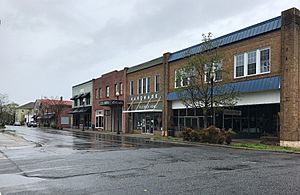Columbia, North Carolina facts for kids
Quick facts for kids
Columbia, North Carolina
|
||
|---|---|---|

Main Street in Columbia
|
||
|
||

Location of Columbia, North Carolina
|
||
| Country | United States | |
| State | North Carolina | |
| County | Tyrrell | |
| Area | ||
| • Total | 1.24 sq mi (3.23 km2) | |
| • Land | 1.23 sq mi (3.18 km2) | |
| • Water | 0.02 sq mi (0.05 km2) | |
| Elevation | 3 ft (0.9 m) | |
| Population
(2020)
|
||
| • Total | 610 | |
| • Density | 496.74/sq mi (191.75/km2) | |
| Time zone | UTC-5 (Eastern (EST)) | |
| • Summer (DST) | UTC-4 (EDT) | |
| ZIP code |
27925
|
|
| Area code(s) | 252 | |
| FIPS code | 37-13940 | |
| GNIS feature ID | 2406300 | |
| Website | www.townofcolumbianc.com | |
Columbia is a town in Tyrrell County, North Carolina, United States. The population was 610 at the 2020 census. It is the county seat of Tyrrell County.
Geography
The Albemarle-Pamlico Peninsula is located in northeastern North Carolina, inshore of Nags Head and the Outer Banks in the Inner Banks region. The peninsula is framed by Albemarle Sound to the north, Alligator River to the east, and the Scuppernong River to the west.
According to the United States Census Bureau, the town has a total area of 0.5 square miles (1.3 km2), all land.
History
Tyrrell County was Named for Sir John Tyrrell, one of the Lords Proprietors of the Carolina colony. Tyrrell County's boundaries originally stretched westward from Roanoke Island to near present-day Tarboro. In 1870, the territory was divided and resulted in what is now known as Tyrrell, Martin, Washington, and Dare counties. Elizabethtown, later renamed Columbia, was established on the banks of the Scuppernong River in 1793, and became the Tyrrell County seat in 1799. [1]
Somerset Place State Historic Site, a representative antebellum plantation dating from 1785, is located near Columbia. Beginning in 1829, this was home to two generations of the Collins family-Josiah Collins III, his wife Mary, and their six sons. It was also home to more than 300 enslaved men, women, and children of African descent whose lives and work are interpreted here as well. Somerset Place offers an insightful view of plantation life during the antebellum period. [2]
The earliest newspaper in Columbia is known as the Eagle[3] and last known issue: April 1, 1943.
Columbia's archaeology and National Register of Historic Places.[4].
Demographics
| Historical population | |||
|---|---|---|---|
| Census | Pop. | %± | |
| 1880 | 166 | — | |
| 1890 | 209 | 25.9% | |
| 1900 | 382 | 82.8% | |
| 1910 | 848 | 122.0% | |
| 1920 | 738 | −13.0% | |
| 1930 | 864 | 17.1% | |
| 1940 | 1,090 | 26.2% | |
| 1950 | 1,161 | 6.5% | |
| 1960 | 1,099 | −5.3% | |
| 1970 | 902 | −17.9% | |
| 1980 | 758 | −16.0% | |
| 1990 | 836 | 10.3% | |
| 2000 | 819 | −2.0% | |
| 2010 | 891 | 8.8% | |
| 2020 | 610 | −31.5% | |
| U.S. Decennial Census | |||
2020 census
| Race | Number | Percentage |
|---|---|---|
| White (non-Hispanic) | 192 | 31.48% |
| Black or African American (non-Hispanic) | 248 | 40.66% |
| Asian | 3 | 0.49% |
| Other/Mixed | 17 | 2.79% |
| Hispanic or Latino | 150 | 24.59% |
As of the 2020 United States census, there were 610 people, 338 households, and 197 families residing in the town.
Notable person
- Brian Rowsom, former NBA player
See also
 In Spanish: Columbia (Carolina del Norte) para niños
In Spanish: Columbia (Carolina del Norte) para niños


